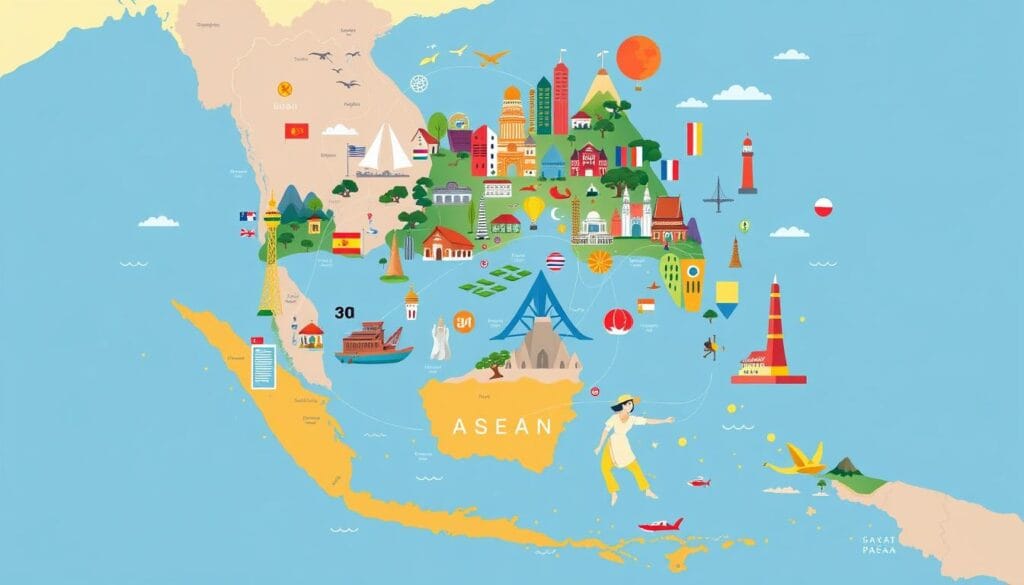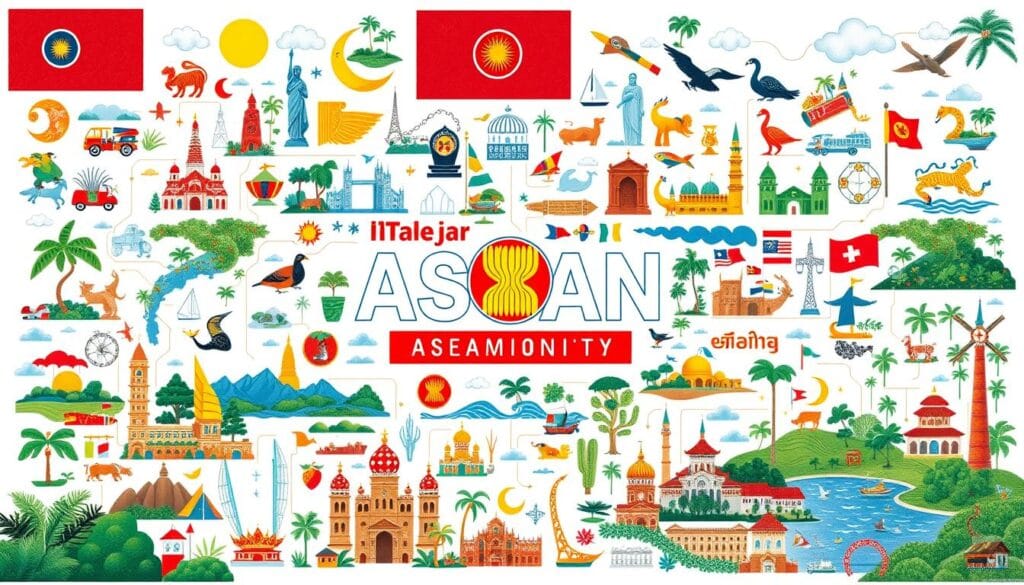ASEAN, Over 650 million people live in Southeast Asia. The region’s economy is expected to become the fourth largest by 2030. This growth is thanks to asean’s focus on working together and growing the economy. More about this

ASEAN is a key player in the global market. It helps its member countries work together economically. You’ll find out about asean’s history and its role in promoting unity and economic growth in southeast asia. More information about ASEAN
Key Takeaways
- ASEAN is a powerful alliance of southeast asian countries that promotes regional integration and economic cooperation.
- The region’s economy is projected to become the fourth largest in the world by 2030.
- ASEAN’s commitment to economic cooperation and regional integration drives growth and development in southeast asia.
- The alliance has a diverse range of member states, each with its own unique culture and economy.
- ASEAN plays a crucial role in promoting economic cooperation and regional integration in southeast asia.
- Understanding ASEAN is essential for businesses and individuals looking to tap into the region’s growing economy.
What is ASEAN? Understanding Southeast Asia’s Powerful Alliance
Exploring ASEAN reveals a strong alliance of asean countries focused on peace, stability, and growth. With a rich history, ASEAN is a key player in global affairs. This makes asean news crucial for understanding the world.
The alliance is built on cooperation, mutual respect, and the well-being of its asean member states. As you dive into ASEAN, you’ll see its mission and values. The asean summit shows the alliance’s dedication to progress.
The Core Mission and Values
ASEAN aims to boost economic growth, social progress, and cultural development. It wants a stable and prosperous region where all asean countries can grow and contribute globally.
Key Objectives in Today’s World
ASEAN focuses on economic integration, regional security, and social and cultural development today. By working together, asean member states tackle challenges and open up new opportunities for growth.
ASEAN’s Global Significance
ASEAN is a major force in international relations. Its role in shaping regional and global affairs is huge. Understanding ASEAN’s mission, values, and goals gives you insight into its global impact.
The Journey Through Time: ASEAN’s Evolution
Exploring asean history reveals key moments that shaped the association of southeast asian nations. It started in 1967 when five countries united. They aimed to boost economic growth, social progress, and cultural development,
In the early days, ASEAN focused on economic cooperation. The ASEAN Free Trade Area (AFTA) was set up in 1992. It aimed to cut trade barriers and boost economic ties among members.
Today, ASEAN has 10 member states. Each brings its own culture, history, and contributions to the region.
Some important events in ASEAN’s history include:
- 1976: The ASEAN Summit was created as the top decision-making body.
- 1995: The ASEAN Regional Forum (ARF) was formed to enhance dialogue and cooperation on security issues.
- 2007: The ASEAN Charter was adopted, outlining the organization’s goals, principles, and structure.
Now, ASEAN is a key player in the global economy, with a GDP over $2.5 trillion. The association of southeast asian nations keeps growing. It focuses on economic integration, social progress, and cultural exchange. Learning about asean history helps understand the region’s complexities and opportunities.
Inside the ASEAN Community: Member States and Their Roles
Exploring the asean community reveals a group of diverse countries. They work together for economic growth, social progress, and cultural development. The list includes Brunei, Cambodia, Indonesia, Laos, Malaysia, Myanmar, Philippines, Singapore, Thailand, and Vietnam.
The asean community is based on cooperation and collaboration. Each member state is crucial to the alliance. Countries must agree to sovereignty, equality, and territorial integrity to join.
Current Member Countries
The current asean member countries are:
- Brunei
- Cambodia
- Indonesia
- Laos
- Malaysia
- Myanmar
- Philippines
- Singapore
- Thailand
- Vietnam

Decision-Making Process
The asean community makes decisions by consensus and cooperation. Each member has an equal voice. This ensures decisions benefit all, promoting stability and prosperity.
ASEAN Economic Community: Your Gateway to Southeast Asian Markets
Exploring the economic community opens up a single market and production base. It offers unmatched trade and investment chances. The asean economic community is a top choice for businesses and investors. It boasts a growing economy and a large consumer base.
The asean economic community allows for the free flow of goods, services, and investments. This economic cooperation among members makes it easy for businesses to succeed. Key benefits include:
- Reduced trade barriers
- Increased market access
- Improved investment opportunities
By joining the asean cooperation, you can access the vast Southeast Asian market. The economic community is perfect for businesses looking to grow. As you explore, you’ll see that economic cooperation unlocks the region’s potential.

Beyond Business: Cultural Integration and Social Development
Exploring the region reveals a vibrant community focused on cultural integration and social development. The asean secretariat is key in this effort, helping member states work together. Keeping up with asean news gives you a peek into the region’s progress and plans.
The area is rich in diverse cultures and traditions. The organization aims to boost mutual understanding and respect. Cultural exchange programs are a big part of this, bringing people together and fostering understanding. The asean summit is where leaders meet to tackle regional challenges, including social and cultural issues.
Some key initiatives include:
- Cultural exchange programs, which promote people-to-people connectivity and social cohesion
- Education initiatives, which aim to improve access to quality education and promote lifelong learning
- Social protection policies, which seek to promote the well-being and welfare of all citizens
ASEAN’s push for cultural integration and social development aims to build a more united and prosperous area. As you delve into the community, you’ll find many opportunities and benefits.
| Initiative | Objective | Outcome |
|---|---|---|
| Cultural Exchange Programs | Promote people-to-people connectivity | Greater mutual understanding and respect |
| Education Initiatives | Improve access to quality education | Improved literacy rates and skills development |
| Social Protection Policies | Promote the well-being and welfare of all citizens | Reduced poverty and inequality |
Conclusion: ASEAN’s Future and Your Role in Southeast Asian Relations
The Association of Southeast Asian Nations (ASEAN) is a key player in shaping the region’s future. It focuses on regional integration and economic cooperation. ASEAN is set to become even more important in the global economy. Yet, it faces many challenges ahead.
ASEAN is working hard to strengthen its bonds and tackle big issues like environmental sustainability and social inequality. Your role as a global citizen is crucial in supporting goals. You can help make Southeast Asia more prosperous and united.
By getting involved in cultural exchange programs and educational initiatives, you can contribute to the region’s growth. Understanding ASEAN’s economic potential can also open up new business opportunities. This can help you build valuable partnerships in Southeast Asia.
As ASEAN evolves, your active support for regional integration and economic cooperation is vital. Together, we can make Southeast Asia a vibrant, inclusive, and sustainable place for everyone.
FAQ
What is ASEAN?
A group of 10 countries in Southeast Asia. It works on regional integration, economic cooperation, and social development. aims to bring peace, stability, and prosperity to the area.
What are the core mission and values of ASEAN?
Main goal is to boost economic growth and social progress. It values national sovereignty, non-interference, and peaceful dispute resolution. The alliance promotes cooperation and shared prosperity among its members.
What are the key objectives of ASEAN in today’s world?
Aims to strengthen regional ties and boost trade and investment. It tackles global challenges and supports sustainable development. The alliance works towards a single market and better connectivity.
How has ASEAN evolved over time?
Started in 1967 with five founding members. It has since grown to 10 members and evolved to face new global issues. Key milestones include the establishment of the ASEAN Economic Community in 2015.
Who are the current member countries of ASEAN?
Members are Brunei Darussalam, Cambodia, Indonesia, Laos, Malaysia, Myanmar, the Philippines, Singapore, Thailand, and Vietnam. Each country contributes to the region’s growth and development.
What are the requirements for joining ASEAN?
To join ASEAN, a country must be in Southeast Asia and agree with ASEAN’s principles. New members are accepted by consensus among current members.
How does the ASEAN decision-making process work?
ASEAN makes decisions by consensus. All members must agree before a decision is made. This approach promotes unity and harmony among diverse members.
What is the ASEAN Economic Community, and how does it benefit businesses and investors?
The Economic Community (AEC) is a single market and production base. It offers great opportunities for trade and investment. The AEC allows for the free movement of goods, services, investments, and labor, giving businesses access to a large market.
How is ASEAN promoting cultural integration and social development in the region?
Promotes cultural exchange and educational initiatives. It also supports social protection policies. These efforts aim to connect people, preserve cultures, and address social challenges.
What is the future outlook for ASEAN, and how can I contribute to Southeast Asian relations?
ASEAN will continue to grow and face new challenges. It will focus on integration, global issues, and sustainable development. You can help by supporting initiatives, promoting cultural exchange, and fostering cooperation.






[…] of climate change solutions and sustainable development. The situation is dire, with 2.2 billion people without safe water. By 2050, cities will face huge water […]